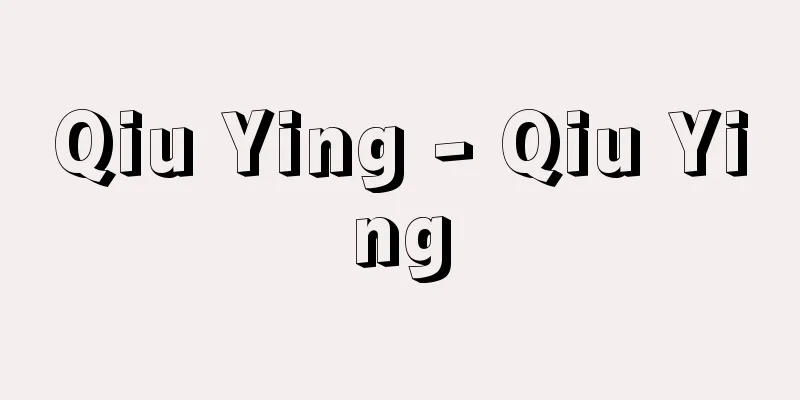Dance - Buyo (English spelling) dance English

|
An art that expresses emotions, intentions, scenes, and situations through rhythmic movements of the body. The Japanese word buyo (dance) was created in the Meiji period as a compound word of mai (dance) and odori (dance), and corresponds to the English word dance, the French word danse, and the German word Tanz. It originates from the Sanskrit word tanha (meaning "desire for life"), which crossed the Hindu Kush and Caucasus mountains into Egypt, and became the Teutonic language tanza from tansa. Both words refer to the desire to act, move, live, and dance with joy. In Japan, a similar word is butoh (dance), which came into general use after the Meiji period and meant social dancing, such as the Rokumeikan ball. The avant-garde dance created by Hijikata Tatsumi in the 1960s also used the word butoh, and became known overseas as butoh. The word "fu" is not used often in the history of dance, but as can be seen in ancient touka songs, the act of "fum" indicates a direct connection to the earth, and is a movement for soothing or calling upon the soul, as in "fumbling on the henbai," and is one of the elements that make up dance. [Masa Ichikawa and Kazuko Kuniyoshi] Definition of DanceIn his book Poetics, the ancient Greek philosopher Aristotle defined dance as "the imitation of character, emotion, and action through the rhythm of bodily form," and this definition remains unchanged today. However, dance that emphasizes character and action tends to become dramatic dance, while dance that emphasizes emotion tends to become pure dance. These two trends have existed in the history of dance in conflict or intertwined relationships. For example, French choreographer Novert advocated ballets d'action (dramatic ballet), while Russian choreographer Balantine advocated pure dance. E. Grosse divided these two trends into gymnastic dance and mimetic dance, while C. Sachs divided them into non-symbolic dance and symbolic dance. Moreover, music aesthetician E. Hanslick defends pure dance by saying that "dance is movement itself, and does not express anything," while dance aesthetician F. This says that "dance has not only form and visible lines, but also meaning and concept," and acknowledges symbolism in abstract forms. Aesthetician S. K. Langer says that "dance creates a world of visible forces through a seamless weave of gestures," and defines dance as an expression of various forces interacting with each other, a dynamic illusion. This theory regards dance as an independent system of meaning, and is an excellent view that views pure dance and dramatic dance from the same perspective. German philosopher Nietzsche defined dance as "the Apollonian perfection of the Dionysian" in his book "The Birth of Tragedy," and French poet Valéry described dance as "the act of transformation itself." [Masa Ichikawa and Kazuko Kuniyoshi] Origin and History of the DanceImages of dancing people can already be seen in the Paleolithic cave paintings of Western Sahara, said to be the world's oldest art. Dance is said to have originated from the rituals of primitive religions, born out of prayer ceremonies to overcome the ravages of nature and disasters such as death and famine. Whirling dances were performed to aim for a state of ecstasy that was one with God, dances in which people stepped on the ground to exorcise demons, the source of disaster, and leaping dances to approach the gods of heaven. As dance moved away from religion, it differentiated into dance to be performed as entertainment for the masses and dance to be viewed. Ballet, which was born during the Renaissance, was originally performed by aristocrats themselves, and there was no division between participants and viewers. Ballet began as a form of wedding banquet, and elements of its banquet art, the "divertissement," and the "grand pas de deux," a dance performed by two young male and female protagonists, remain strong in classical ballets from the late 19th century, such as "Swan Lake" and "Sleeping Beauty." In the 20th century, Diaghilev's Ballets Russes (Russian ballet company) rejected the fairy tale world of classical ballet, eliminated absurd developments and decorative compositions, and performed a series of works that were called modernist dance, the representative choreographer of which was Fokine. Another contemporary who rejected classical ballet and pioneered new dance was the American dancer Duncan, who danced barefoot and in a thin costume, free from conventions. This ideology blossomed in the 1920s and 1930s, giving rise to Expressionism in Germany by Laban and Wigman, and modern dance by Graham in America. Both focused on expressing inner feelings. In response to this expressive dance, Cunningham appeared in the United States in the 1950s and produced abstract works that pursued the movement of the body itself. From his students came Trisha Brown (1936-2017), Twyla Tharp (1941- ), and other artists known as postmodern dancers, who created a new whirlwind. Meanwhile, in Germany in the 1970s, expressive dance called Tanztheater, led by Bausch, was revived and attracted worldwide attention. In Japan, Tatsumi Hijikata's "dark dance" was born around the same time, and a movement that greatly changed the way we think about dance was born. This global trend of reconsidering the concept of dance, which became evident from the 1960s, also brought about a new wave called Nouvelle Danse in France and Belgium in the 1980s. In addition, physical theater, characterized by acrobatic movements, is also a new trend in contemporary dance at the end of the 20th century. [Masa Ichikawa and Kazuko Kuniyoshi] Western and Eastern DanceWestern dance, even modern dance, is based on ballet and is determined by the form of ballet. It is basically called en dohors, and is characterized by the center of gravity being placed on the outer legs with the hip joints open outward and around the chest. This results in a wide variety of leg expressions, steps and jumps. In contrast, Eastern dance often involves lowering the hips and lowering the center of gravity, and lightly relaxing the knees. Kagura and Kabuki dance, as well as most Southeast Asian dances, have a lower center of gravity and place emphasis on hand expression. Spanish flamenco can also be considered an Eastern dance, as it involves lowering the hips and not jumping. This can also be seen as a physical difference between hunter-horseback and farming peoples. Another big difference between Western and Eastern dance is that in many Eastern dances, even in round dances, people do not hold hands. Dances such as Japanese Bon Odori, Indian dance, Balinese dance, and flamenco do not involve holding hands. On the other hand, in the Balkans' Kolo and most European folk dances, people hold hands when dancing. It is also possible to distinguish between Western and Eastern dances from the perspective of contact and non-contact dance. [Masa Ichikawa and Kazuko Kuniyoshi] "The Aesthetics of Dance" by Gunji Masakatsu (1957, Engeki Shuppansha) ▽ "World Dance History" by C. Sachs, translated by Ogura Shigeo (1972, Ongaku No Tomosha) ▽ "Letters on Dance and Ballet" by J.G. Nover, translated by Ogura Shigeo (1974, Tomiyamabo) ▽ "History of Dance" by Ishifuku Tsuneo (1974, Kinokuniya Shoten) ▽ "History of Dance" by A. Haskell, translated by Sanseido Editorial Office (1974, Sanseido) ▽ "Principles of Dance Theory" by M.N. Dobler, translated by Matsumoto Chiyoe (1980, Taishukan Shoten) ▽ "Sacred Dance" by M. Vaugin, translated by Ichikawa Masa (1981, Heibonsha) ▽ "Cosmology of Dance" by Ichikawa Masa (1983, Keiso Shobo)" ▽ "Dance and the Body" by Ashihara Eiryo (1986, Shinjuku Shobo)" ▽ "Crossing Nouvelle Danse" by Maeda Makoto (1995, Shinshokan)" ▽ "Dance in the 20th Century" by Ichikawa Masa (1995, Shinshokan)" ▽ "History of Modern Dance" by Unno Hiroshi (1999, Shinshokan)" ▽ "The Distance of Seeing: The Trajectory of Dance 1962-1996" by Ichikawa Masa and Kuniyoshi Kazuko (ed.) (2000, Shinshokan)" ▽ "Dance of the World: Ethnic Dances, Their History and Culture" by Gerald Jonas, translated by Tanaka Sachiko and Yamaguchi Junko (2000, Taishukan Shoten)" ▽ "Cultural History of Dance" by Kuni Masami (Iwanami Shinsho) [References] | | | | | | | | | | | | | | | | | | | | | | | | | | | | | | | |Source: Shogakukan Encyclopedia Nipponica About Encyclopedia Nipponica Information | Legend |
|
身体のリズミカルな動作により感情や意思、情景や状況などを表現する芸術。舞踊という日本語は「舞(まい)」と「踊り」の合成語として明治時代につくられたもので、英語のdance、フランス語のdanse、ドイツ語のTanzに相当する。これはサンスクリット語のtanha(「生の欲望」の意)を語源とし、ヒンドゥー・クシ、カフカスの両山脈を越えてエジプトに入り、tansaからチュートン系の言語tanzaとなった。いずれも、行為し、動き、生き、喜悦して踊る欲望をさすことばである。日本では類似したことばに「舞踏」があり、一般的には明治以降に使われるようになり、鹿鳴館(ろくめいかん)の舞踏会のように社交ダンスを意味した。また、1960年代に土方巽(ひじかたたつみ)が創始した前衛舞踊も「舞踏」の語を用い、butohとして海外にも知られるようになった。「踏」という語は舞踊史上あまり用いられないが、上代の踏歌(とうか)にもみられるように、「踏む」という行為は大地との直接的な関係を示し、「返閇(へんばい)を踏む」というように鎮魂や招魂のための動作であり、舞踊を構成する要素の一つである。 [市川 雅・國吉和子] 舞踊の定義古代ギリシアの哲学者アリストテレスはその著『詩学』のなかで、「舞踊とは身体的形態のリズムによって性格と情緒と行為を模倣するもの」と定義しているが、これは今日でも変わらない。ただし、性格や行為を強調した舞踊は劇的舞踊になり、情緒を強調した舞踊は純粋舞踊になる傾向がある。この二つの流れは舞踊史のなかで対立し、あるいは絡み合って存在している。たとえば、フランス出身の振付家ノベールはバレエ・ダクション(劇的バレエ)を主張し、ロシア出身の振付家バランチンは純粋舞踊を唱えた。この二つの流れを、E・グロッセは体操的舞踊と模擬的舞踊に分け、C・ザックスは非象徴的舞踊と象徴的舞踊とに分けている。また、音楽美学者E・ハンスリックは「舞踊とは動きそのものであって、なにものも表現しない」と純粋舞踊を擁護し、舞踊美学者F・ティスは「舞踊は形式と可視線だけでなく、意味と概念をもっている」といい、抽象的な形式のなかに象徴性を認める発言をしている。美学者S・K・ランガーは「舞踊とは身ぶりの切れ目のない織物によって目に見えるさまざまな力の世界を創造するもの」といい、舞踊は互いに作用するいろいろな力の表現であり、ダイナミックな仮象であると定義している。この説は舞踊を自立した意味の体系とみなし、純粋舞踊と劇的舞踊を同一の視点からとらえた優れた見解といえる。ドイツの哲学者ニーチェはその著『悲劇の誕生』のなかで、「舞踊とはディオニソス的なもののアポロン的完成」と定義し、フランスの詩人バレリーは舞踊とは「変身の行為そのもの」と述べている。 [市川 雅・國吉和子] 舞踊の起源と歴史舞踊する人々の姿は、世界最古の芸術といわれる旧石器時代の西サハラの壁画などにすでに描かれている。舞踊は原始宗教の儀式から発生したといわれ、自然の猛威、死や飢餓などの災厄を乗り切るための祈願の儀式のなかから生まれた。神との一体的な恍惚(こうこつ)を目ざすために旋回舞踊が、災厄の基である悪魔を祓(はら)うために大地を踏む舞踊が、天界の神に近づくために跳躍する舞踊が行われた。 やがて舞踊は宗教から遠ざかるにつれて、民衆娯楽としての踊る舞踊と鑑賞する舞踊とに分化していく。ルネサンス期に生まれたバレエも、最初は貴族自らが踊り手で、まだ参加する者と鑑賞する側とに分かれていなかった。バレエは結婚式の祝宴の形式として始まったが、その宴会芸「ディベルティスマン」と若い主役の男女2人の踊り「グラン・パ・ド・ドゥ」の要素は、19世紀末の古典バレエ『白鳥の湖』や『眠れる森の美女』などに色濃く残っている。20世紀に入り、ディアギレフのバレエ・リュス(ロシア・バレエ団)が古典バレエのメルヒェン的世界を否定し、荒唐無稽(こうとうむけい)な展開と装飾的な構成を排して、舞踊のモダニズムといわれる作品を次々と上演したが、その代表的振付家はフォーキンであった。同時代に同じく古典バレエを否定し、新しい舞踊を開拓した人にアメリカ出身のダンカンがいるが、彼女ははだしに薄い衣装を着けただけで、型にとらわれず自由に踊った。この思想は1920~1930年代に開花し、ドイツではラバン、ウィグマンらの表現主義が生まれ、アメリカではグレアムのモダン・ダンスが誕生した。ともに内面的な感情表現に主眼を置いたものである。 こうした表現的舞踊に対して、1950年代にアメリカではカニンガムが登場し、身体の動きそのものを追求する抽象的作品を発表した。その門下からブラウンTrisha Brown(1936―2017)、サープTwyla Tharp(1941― )ら、ポスト・モダン・ダンスとよばれる作家たちが輩出し、新しい旋風を巻き起こした。一方、ドイツでは1970年代に、バウシュを筆頭にタンツ・テアターとよばれる表現的な舞踊が再興し、世界的な脚光を浴びた。日本でも同時期に土方巽による「暗黒舞踏」が誕生し、従来の舞踊に対する考え方を大きく変える動きが生まれていた。このように1960年代から顕著になった舞踊概念の見直しの世界的な傾向は、1980年代のフランス、ベルギーにもヌーベル・ダンスというニュー・ウェーブをもたらすことになった。そのほか、アクロバティックな動きを特徴とするフィジカル・シアターも20世紀末の現代ダンスに指摘できる新しい傾向のダンスである。 [市川 雅・國吉和子] 西洋舞踊と東洋舞踊西洋舞踊はモダン・ダンスであってもバレエを母体にし、バレエの形式によって決定づけられており、基本的にはアン・ドゥオールといい、股(こ)関節が外に開く外輪(そとわ)の脚部と胸のあたりに重心があることに特徴がある。そのため脚部の表現、ステップの種類と跳躍が多くなる。逆に東洋舞踊は、腰を落とし重心を低くし、膝(ひざ)を軽く緩めていることが多い。神楽(かぐら)や歌舞伎(かぶき)舞踊、東南アジアの舞踊のほとんどは、重心を低くし、手の表現に重点を置いている。スペインのフラメンコなども、腰を低くし跳躍しない点からみて東洋の舞踊といえる。これは狩猟・騎馬民族と農耕民族の身体的相違とも考えられる。 西洋舞踊と東洋舞踊のもう一つの大きな相違は、東洋舞踊ではその多くが、たとえ輪舞でも手を取り合うことがない点である。日本の盆踊り、インド舞踊、バリ島の舞踊、フラメンコなど手をつないで踊ることはない。一方、バルカン半島のコロ、ヨーロッパのフォーク・ダンスのほとんどは、手を取り合って踊る。接触舞踊と無接触舞踊という角度から、西洋と東洋の舞踊を分けることも可能である。 [市川 雅・國吉和子] 『郡司正勝著『をどりの美学』(1957・演劇出版社)』▽『C・ザックス著、小倉重夫訳『世界舞踊史』(1972・音楽之友社)』▽『J・G・ノヴェール著、小倉重夫訳『舞踊とバレエについての手紙』(1974・冨山房)』▽『石福恒雄著『舞踊の歴史』(1974・紀伊國屋書店)』▽『A・ハスケル著、三省堂編修所訳『舞踊の歴史』(1974・三省堂)』▽『M・N・ドウブラー著、松本千代栄訳『舞踊学原論』(1980・大修館書店)』▽『M・ヴォージン著、市川雅訳『神聖舞踏』(1981・平凡社)』▽『市川雅著『舞踊のコスモロジー』(1983・勁草書房)』▽『蘆原英了著『舞踊と身体』(1986・新宿書房)』▽『前田允著『ヌーヴェルダンス横断』(1995・新書館)』▽『市川雅著『ダンスの20世紀』(1995・新書館)』▽『海野弘著『モダンダンスの歴史』(1999・新書館)』▽『市川雅著、國吉和子編『見ることの距離――ダンスの軌跡1962~1996』(2000・新書館)』▽『ジェラルド・ジョナス著、田中祥子・山口順子訳『世界のダンス――民族の踊り、その歴史と文化』(2000・大修館書店)』▽『邦正美著『舞踊の文化史』(岩波新書)』 [参照項目] | | | | | | | | | | | | | | | | | | | | | | | | | | | | | | | |出典 小学館 日本大百科全書(ニッポニカ)日本大百科全書(ニッポニカ)について 情報 | 凡例 |
Recommend
Rammed Earth - Hanchiku
A method of compacting earth to build a building&#...
Frozen food - Reitoushokuhin (English spelling) frozen food
This refers to food that has been frozen to give ...
Kirigami (forex) - Kirigami
…Those who traded in coins were called kaezeni, k...
teen tāl (English spelling) teental
…In modern art music, 35 types of talas are defin...
Ryoanji Temple
This is a temple of the Myoshinji school of the Ri...
Bellovaci
...It was formed in the 3rd century BC by a mixtu...
Writing book - Writing book
…This term was used frequently in the Edo period,...
Washington clam (milk mussel)
A bivalve mollusks of the family Muscidae (illustr...
Baylis, L. (English notation) BaylisL
…In 1933, it was renamed the Royal Victoria Theat...
precocious menstruation
…It can occur for a variety of reasons. [Menarche...
Odontoglossum
This epiphytic orchid is native to the tropical An...
Tarim Basin - Tarim Basin
A basin in the southern part of the Xinjiang Uygh...
Snow partridge
…Among the partridges, the European partridge ( P...
Wagner, Wolfgang (English spelling) WagnerWolfgang
...German composer. His librettos for music drama...
Agricultural production organization
Much of Japan's agricultural production is ca...









